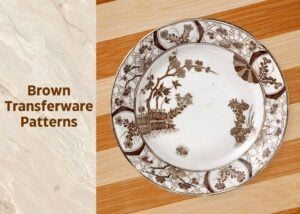Transferware is a type of ceramic, usually earthenware or ironstone, which is decorated using a technique called transfer-printing. Potters etched a pattern onto an engraved copper plate, transferred the image onto special tissue paper, and then pressed the paper onto the ceramic piece.
Now, transferware was made in many colors, such as blue, pink, red, and green, but brown transferware has a unique and enduring appeal. Sepia hues of the richer, earthier sort were always loved for how they blend with natural, country, or farmhouse decorating styles.
If you’re into collecting this beautiful, warm, and cozy-looking ware, I’ve listed below some of the most valuable brown transfer patterns that you’ll become a fan of! These designs not only blend with cozy kitchen settings, but also hold collectible value!
1. “Old Britain Castles” by Johnson Brothers
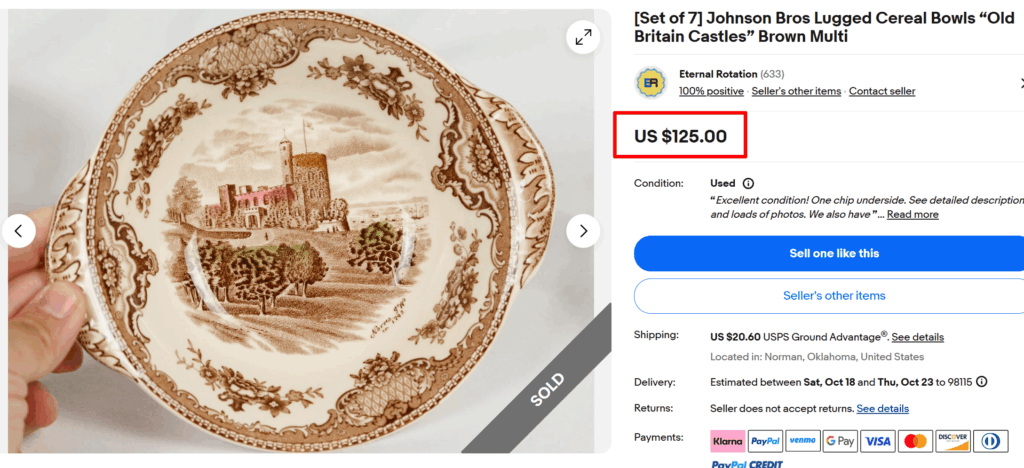
Johnson Brothers’ Old Britain Castles brown transferware series is incredibly popular. This set of seven lugged cereal bowls shows the iconic, lifelike design featuring various British castles in brown multi-tones.
The company made this amazing pattern in several colors, like blue, brown (multicolor), and pink. Among these, only the pink version is continued; brown Old Britain Castles transferware is no longer in production, making this rare and valuable.
2. “Woodland Beaver Winter Scenes” by Spode (1990s)
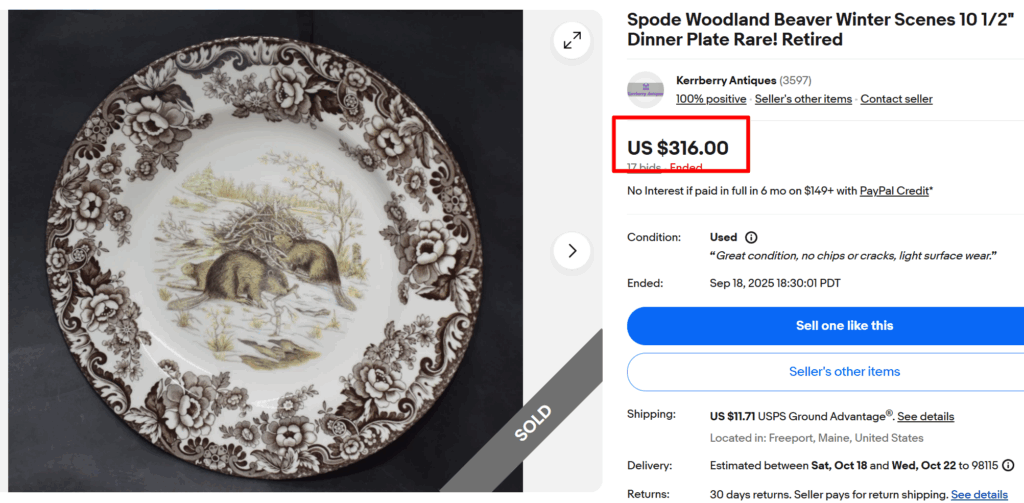
The Beaver Winter Scenes is a retired transferware pattern from Spode’s Woodland series, released in the 1990s. It shows beavers in their winter habitat with a highly elaborate floral scroll border.
You will also see hand-colored accents in soft greens and yellows that pop out against the brown transfer and create depth. Since it’s a retired design, even single pieces in great condition can fetch a few hundred dollars. Sets can go for $500+!
3. “Napoleon Revolt of Cairo” by C. J. Mason (1830s – 1840s)
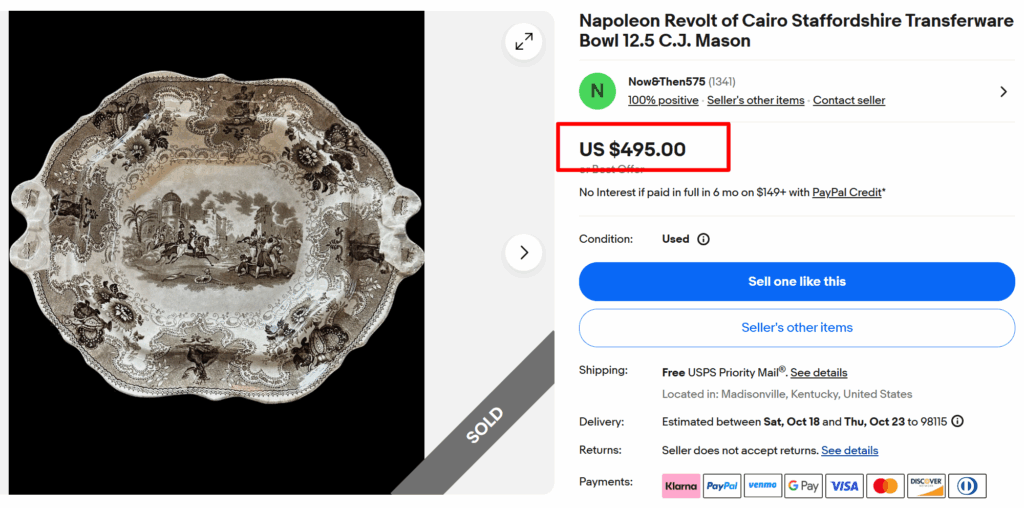
This dramatically large bowl shows a detailed scene of Napoleon’s Egyptian campaign with soldiers, palm trees, and Cairo architecture. This historical design was made by the Staffordshire maker C.J. Mason around 1826, as a part of their popular series, “Napoleon’s Battles.”
Transferware dishes with such specific historical events are rarer and more valuable than generic pastoral scenes; no wonder this single bowl sold for almost $500!
4. “Quail” by Furnivals Pottery (1913, 1921 – 1968)
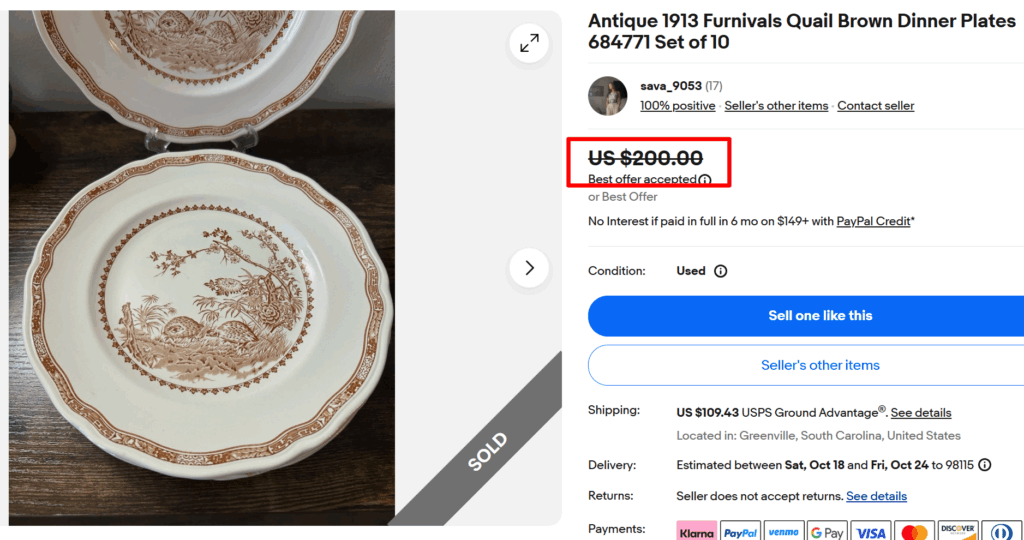
A set of 10 dinner plates from 1913 featuring Furnivals Pottery’s beloved Quail pattern (catalog #684771). It has scalloped edges and an encircled quail bird design at the center. Furnivals’ wildlife patterns are popular among country-style collectors. But finding intact pieces from over 100 years ago is tough, so they can go fetch $150 to $250+.
5. “Heritage Hall” by Johnson Brothers (1969 – 1985)
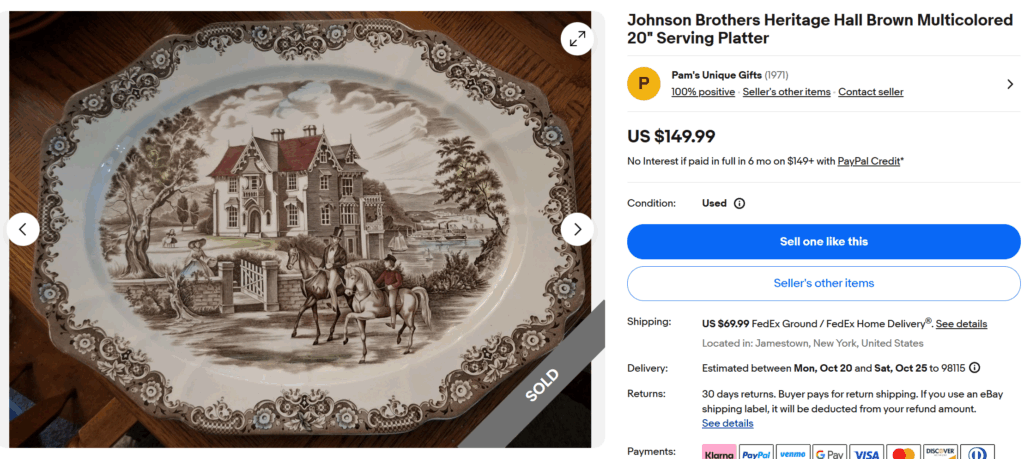
This massive platter shows Johnson Brothers’ iconic “Heritage Hall” pattern featuring a classic pastoral scene with a manor house, horses, and countryside details. The brown, multicolored transfer work is decorated with intricate, delicate floral borders. Large serving dishes with this transferware pattern are perfect for holiday gatherings!
6. “Melbourne” by Various Staffordshire Potteries (1883)
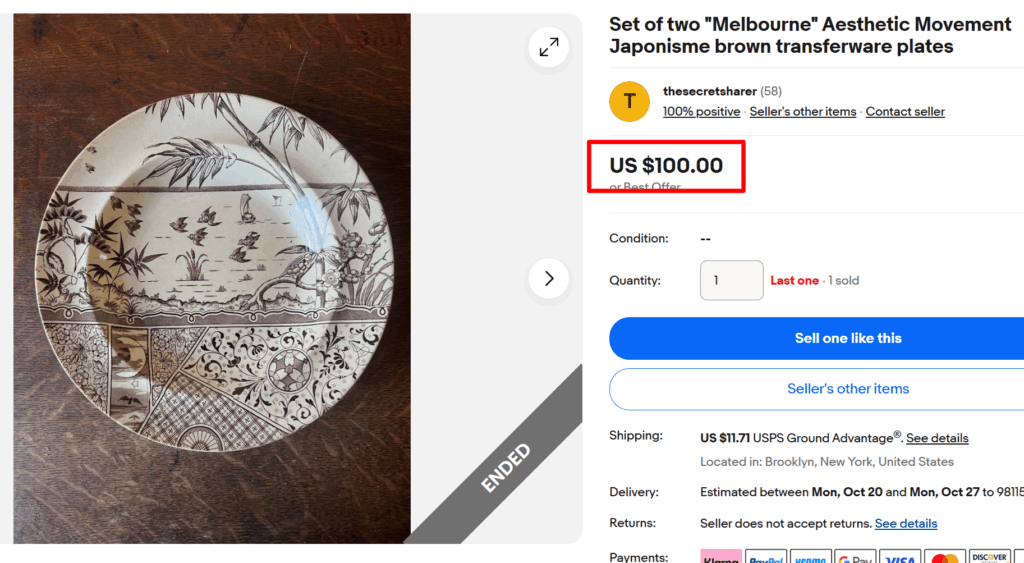
The Melbourne pattern was made by several Staffordshire potteries in the early 1880s. This example is from Gildea and Walker. The design is a blend of Victorian obsession and Japanese design, inspired by the Aesthetic Movement.
So, you will see Eastern elements, like bamboo, birds in flight, decorative fans, along with sectioned borders showing different ornate patterns. It’s a cool fusion that many collectors look for today.
7. “Tonquin” by Royal Staffordshire (1940s – 1950s)
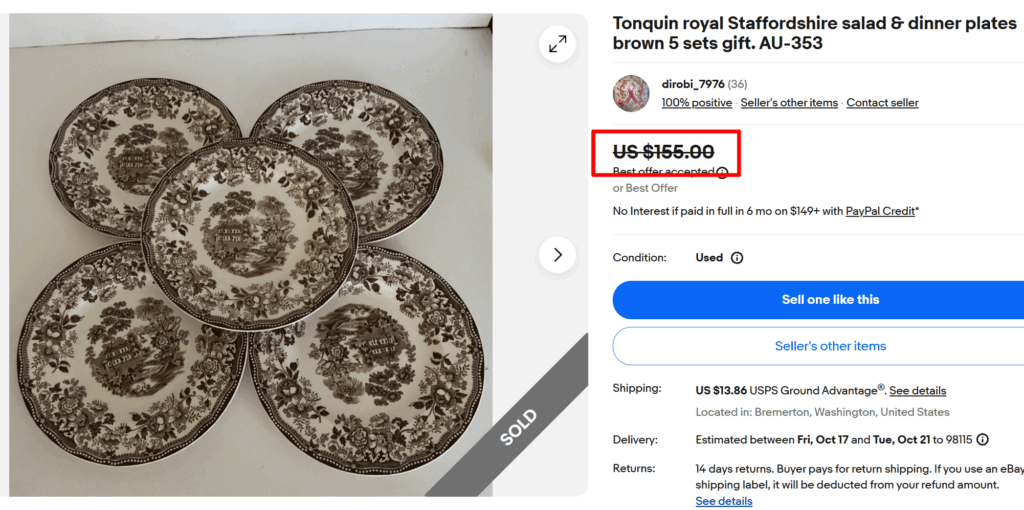
The Tonquin pattern from Royal Staffordshire is super popular among brown transferware collectors. It displays a highly detailed and dense design of Asian-inspired pagodas, willow trees, and garden scenes.
But since Tonquin’s been reproduced, check for authentic “Royal Staffordshire” backstamps. Mint-condition plates can easily sell for $20-$25, while sets like these can fetch $50 to $170, as they’re harder to find than individual pieces.
8. “Delamere” by Spode (2002 – Present)
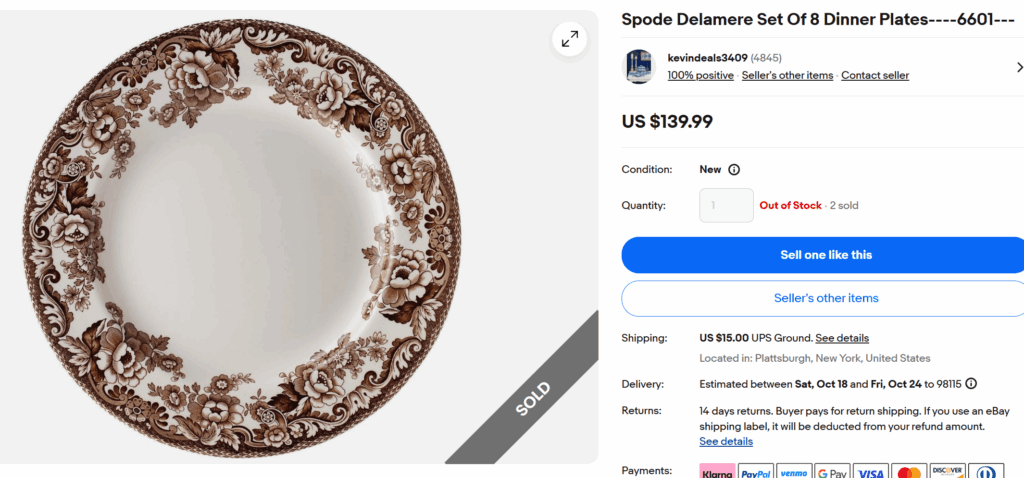
Spode’s Delamere pattern (#6601) shows elegant brown scrollwork of cascading flowers on the border. New-in-box sets like this set of 8 dinner plates are highly desirable for collectors, especially during the holiday season. Even single plates can fetch $15 to $25.
9. “Marmora” by William Ridgway & Co. (1830 – 1854)
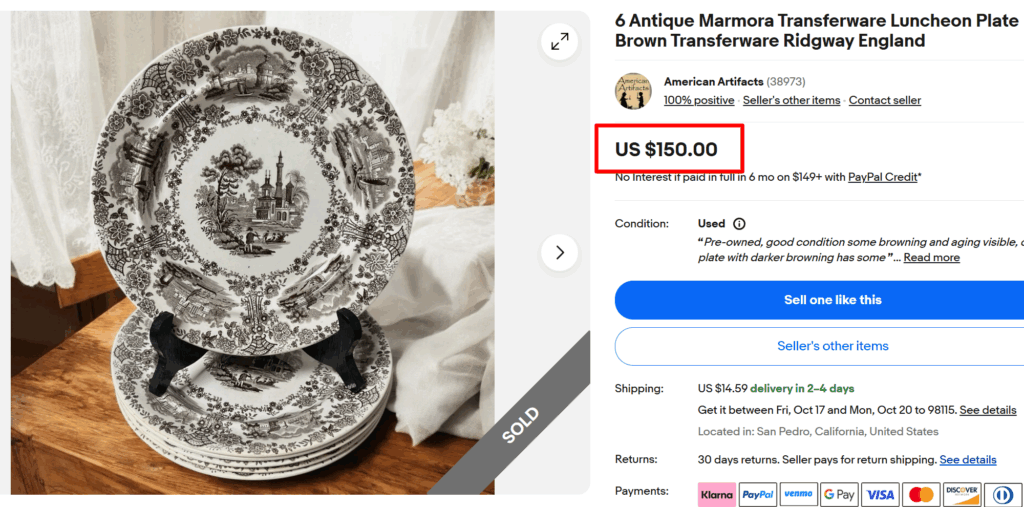
This gorgeous set of six luncheon plates features the antique Marmora pattern from England’s Ridgway pottery. This highly elaborate pattern showcases architectural scenes with mosques and Eastern landscapes, plus floral garland designs framing each scene.
Ridgway was known for such exotic patterns during the Victorian era, which is why these plates can sell for $100 to $150 or higher for complete dinnerware sets.
10. “Friendly Village” by Johnson Bros (1953 – 2003)
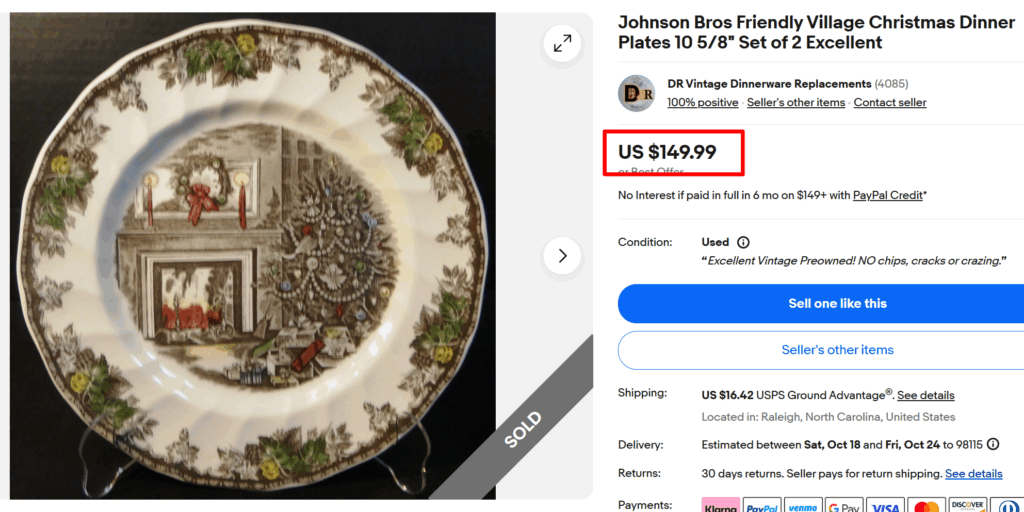
This Johnson Brothers design makes a perfect topper for a Christmas dinner table. It’s a cozy fire scene with stockings, garland, and holiday playfulness.
While the base decoration is brown, you may see green and red accents, which make the design pop out! This Christmas version is more collectible than the regular Friendly Village patterns.
11. “Yosemite” by T. & R. Boote (1880s)
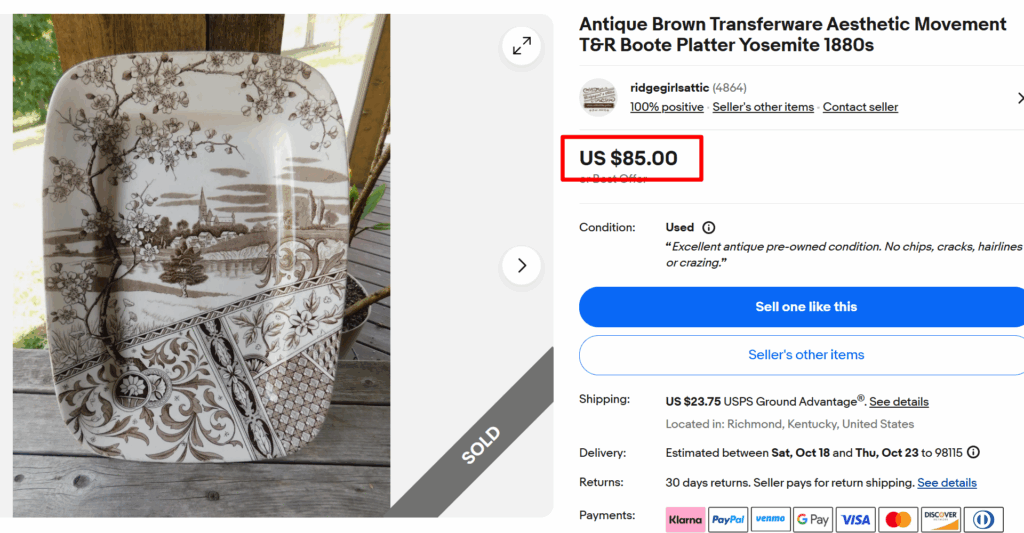
Dating to the 1880s, this brown transferware platter shows Yosemite’s natural beauty! You’ll see delicate cherry blossoms and nature scenes often with geometric borders, likely inspired by Yosemite National Park. These brown dishes were hugely popular in Victorian homes.
Finding Yosemite pieces in such great shape with no chips, cracks, or crazing is not easy. So, expect them to sell for $50 to $100 for individual pieces like these. Sets can be worth even more!
12. “Greek Key” by Spode Copeland
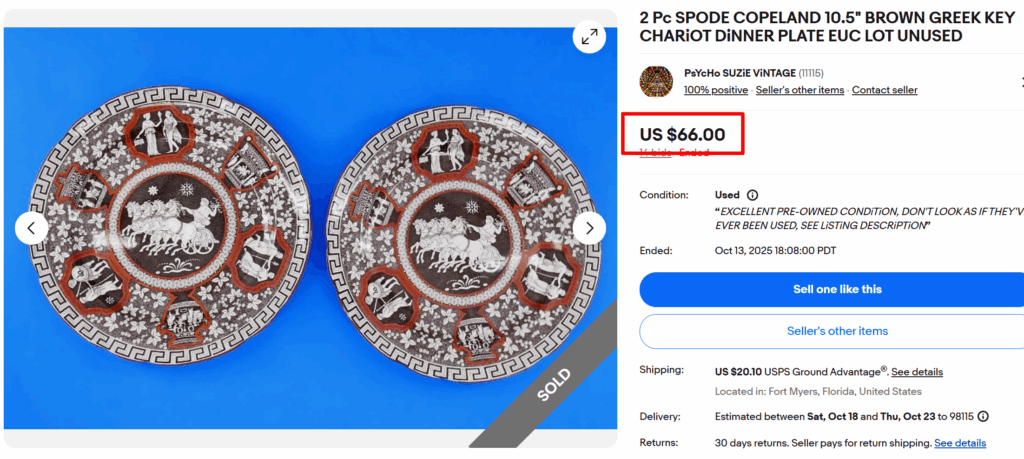
These large 10.5″ plates feature Spode Copeland’s popular “Greek Key” pattern in brown. You will see ancient chariots and classical figures in decorative medallions with highly detailed geometric borders. This pattern has been made since 1804 until the later Copeland era. So, check and research the backstamps to find out how old your transferware really is.
13. “Melton” by Wedgwood (1883)
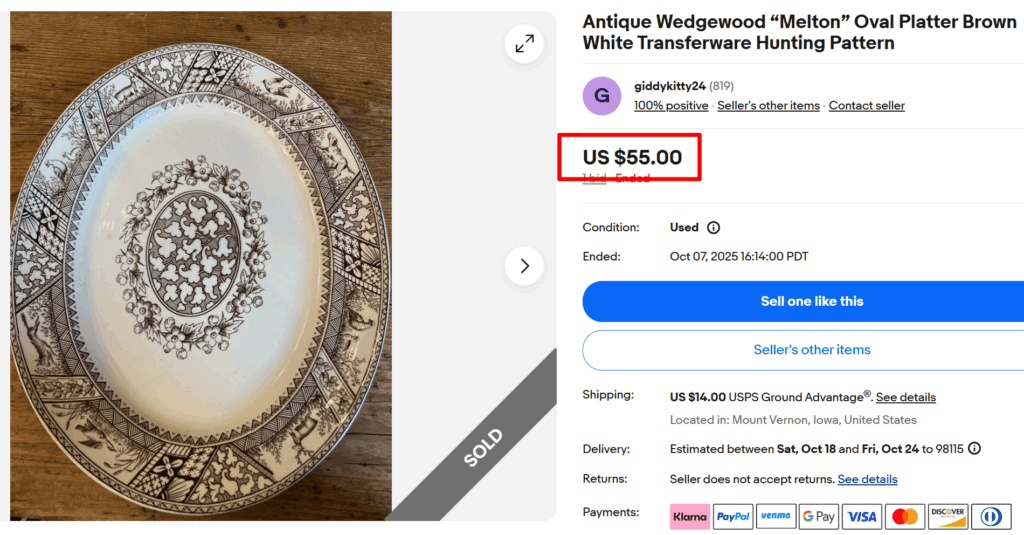
Wedgewood’s Melton pattern from 1883 oozes true countryside charm with brown transfer hunting scenes. The oval shape and intricate floral borders frame vignettes of hunters, dogs, and wildlife. This pattern’s less common than some Wedgewood classics, but that’s what makes it a perfect find for someone who wants something different.
Also, Wedgwood reproductions are common. So, double-check the Wedgewood mark for sharper details in the transfer design.
14. Brown “Aleppo” by Clementson Young (1844 – 1845)
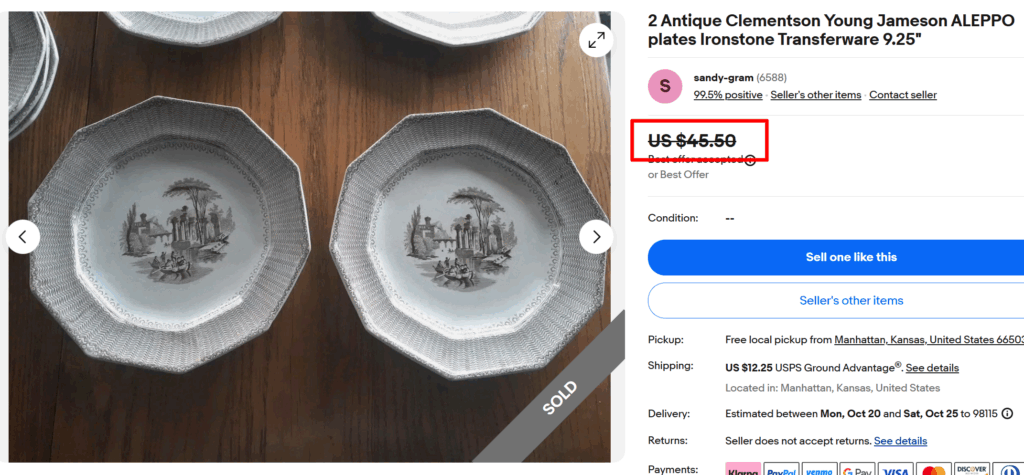
Measuring 9.25 inches, these unique decagonal plates from Clementson Young feature the Aleppo pattern, noted for its exotic Middle Eastern ruins and palm trees. The borders of the plates also show a fine basket-weave design.
When collecting these brown transferware pieces, look for the logo and “Clementson, Young & Jameson” stamp and pattern name on the back. If you see only “Clementson” or “Clementson, Young,” it’s likely fake.
15. “The Post House” by Wood & Sons (1950s & 1960s)
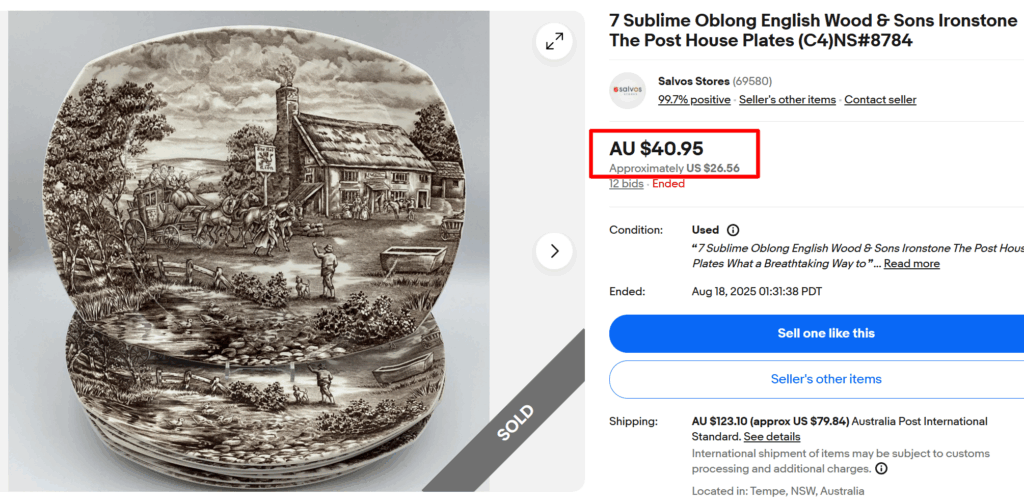
These oblong Wood & Sons plates feature their “The Post House” coaching scene with incredible detail. The brown transfer shows a bustling inn with carriages and travelers. Made from durable English ironstone, Wood & Sons dishes are known for their storytelling scenes.
Guide to Collecting Brown Transferware
Buying or selling, don’t just trade your antique transferware! Here are some important clues for authenticity and value that you need to consider to spot collectible pieces.
- Look Out for the Patterns: Learn about the popular brown transferware patterns. Find out whether a pattern was actually made in brown color or not, to spot the fakes. Also, do research to see what value a specific pattern holds in the antique market.
- Explore the Type: The most valuable items are pieces made in smaller quantities. Look for covered tureens (soup or sauce dishes), massive platters, pitchers, or novelty pieces like butter pats and egg cups. These rare shapes are much more desirable than plates.
- Check the Backstamp: Always check the underside of the dishes. Most potteries marked their transferware with unique logos, pattern names, date codes, etc. These marks are crucial for identifying authentic pieces. Also, “Made in England” marks mean post-1921 ware.
- Inspect the Condition: Look for wear signs. The fine network of lines in the glaze (crazing) is almost always present in old transferware and is normal. But damage like hairline cracks, chips on the rim, or paint repairs will reduce the value.
Note: This article is intended for informational, educational, and entertainment purposes only. Some images are illustrative and may not represent actual brands, products, or related entities. All trademarks, product names, brand logos, packaging, and other intellectual property referenced remain the exclusive property of their respective owners. Any brand mentions or references are provided solely for descriptive and educational context and do not imply any formal or commercial association.

